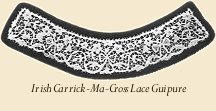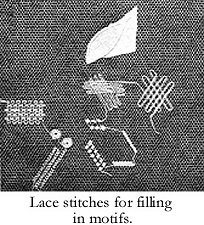

Click on thumbnails to enlarge.
There are two kinds of this beautiful Irish lace in vogue at the present time, the appliqué and the guipure. Its being a favorite lace with the present Queen of England has caused a great demand for the exquisite fabric, her recent orders for including a court train in a combination of the two kinds. By no mean as durable s the famous Irish crochet, it can never be done so common, because of its higher prices and fragility. It is greatly prized by those who can afford it for wedding gowns, evening dresses and trousseaus. As it is very easily made and much quicker to work than Irish crochet, there is no reason why any woman who can sew neatly should not make a quantity of small pieces, such as the neckbands shown here, all that is requisite being some fine Brussels net, white or cream, sheer cambric muslin, a very fine sewing needle, a sharp scissors, coarse, twisted crochet cotton for the outlining, and the very finest sewing thread. In the latter there are several makes in Irish lace thread, varying in number from 100 to 250.

Whatever the design is to be used must be first drawn on a piece of white, stiff paper such as drawing paper, if it cannot be obtained printed on a cotton material. Draw the design first with a pencil, then go over the lines somewhat heavily with pen and ink. Rub out all trace of the lead pencil, otherwise the work will be spoiled, as it is absolutely necessary to keep it clean as possible. For this purpose, all of the article not being worked upon should be kept covered during the process of working, and a piece of white tissue paper held between it and the thumb of the left hand which rests upon it.

Over the design the net is smoothly tacked around the edge, the muslin is laid over the net and also tacked, putting the stitches outside the lines of the design and sewing them closely enough to keep the net secure in place. Now take the coarse crochet cotton and lay it along the outline at the left hand corer, and with the fin thread and a very fine needle-so that it may not leave a visible hole in the muslin after the stitch-couch or overcast the outlining thread with very close, even and neat stitches to both muslin and net taken together. Go over the entire outline in this way. At the outer edge twist the thread into a small loop and secure with a few tight stitches through the center to form a picot. These are made at about an eighth of an inch apart around the edge.
Remove the lace from the design by cutting the threads on the back of the design; then with a sharp scissors cut away the muslin from the outside of the design, taking the utmost care not to cut the net, as this would entirely ruin the work. How place the lace in an embroidery hoop, such as you use for small pieces of embroidery, and fill in the motifs of the design with any or all of the lace stitches shown in the details. The number of filling stitches is merely a matter of individual fancy. Some like a clear background to the design, while many prefer all the spaces filled in. As a general rule, the greater the quantity of work put into the lace, provided the stitches are well chosen, the more valuable the lace becomes.

Placing the lace face downward on an ironing board between the folds of damp muslin and pressing with a hot iron completes it.
The guipure lace is made in much the way, but without the net, the various motifs being connected, while overcasting the outline, with buttonholed bars as in ordinary cut-work and the bars being frequently embellished with little picots buttonholed over.
Note: This article was taken from a 1912 issue of McCall's Magazine and was written by a Marie Murray. The techniques describe here have not been tried, and therefore Across the Ages cannot vouch for their work-ability. The instructions and/or patterns provided here are for your own use only, and may not be reproduced in any form for sale or commercial use.
Please contact the webmaster if you are experiencing any technical difficulties with this site.
About
Additions
Articles
FAQ
Feature
Links
Poll
Reviews
Resources
Sewing
©2003 Across the Ages